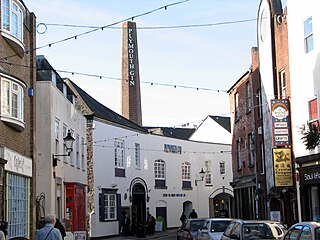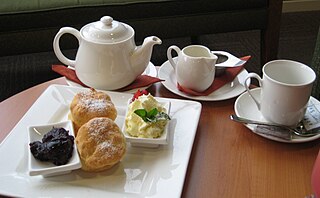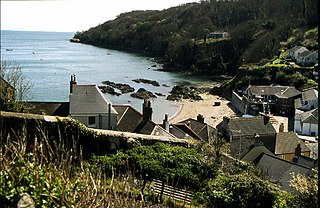
Dartmouth is a town and civil parish in the English county of Devon. It is a tourist destination set on the western bank of the estuary of the River Dart, which is a long narrow tidal ria that runs inland as far as Totnes. It lies within the South Devon Area of Outstanding Natural Beauty and South Hams district, and had a population of 5,512 in 2001, reducing to 5,064 at the 2011 census. There are two electoral wards in the Dartmouth area. Their combined population at the above census was 6,822.

Plymouth is a port city and unitary authority in Devon, South West England. It is located on Devon's south coast between the rivers Plym and Tamar, about 36 miles (58 km) southwest of Exeter and 193 miles (311 km) southwest of London.

Plymouth Sound, or locally just The Sound, is a deep inlet or sound in the English Channel near Plymouth in England.

Salcombe is a resort town in the South Hams district of Devon, south west England. The town is close to the mouth of the Kingsbridge Estuary, mostly built on the steep west side of the estuary. It lies within the South Devon Area of Outstanding Natural Beauty (AONB). The town's extensive waterfront and the naturally sheltered harbour formed by the estuary gave rise to its success as a boat and shipbuilding and sailing port and, in modern times, tourism especially in the form of pleasure boats and yachting. The town is also home to a traditional shellfish fishing industry. The town is part of the electoral ward of Salcombe and Malborough, for which the 2011 census recorded a total population of 3,353.

Newlyn is a seaside town and fishing port in south-west Cornwall, England, United Kingdom. It is the largest fishing port in England.

The Plymouth Gin Distillery is a gin manufacturer on The Barbican, Plymouth, England. Also known as the Black Friars Distillery, it is the only gin distillery in the city. The original building opens on to what is now Southside Street. Established in 1793, it is the oldest operating distillery in Britain.

Plymouth Gin is a style and brand of gin that has been distilled on the same premises on the Barbican in Plymouth, Devon, since 1793. The site of production, the Plymouth Gin Distillery, was built in 1431 and is reputed to have once been a monastery of the Dominican Order, widely known as "Black Friars". For this reason, it has traditionally been called the "Black Friars Distillery", and this name appears embossed on the gin bottles. The taste profile of the style has been described as "earthy", and featuring more citrus notes than the "London Dry" gin style, of which Plymouth Gin is considered an offshoot, or subtype.

The city of Plymouth, Devon, England is bounded by Dartmoor to the north, the Hamoaze to the west, the open expanse of water called Plymouth Sound to the south and the river Plym to the east.

The Mayflower Steps are close to the site in the Barbican area of Plymouth, south-west England, from which the Pilgrim Fathers are believed to have finally left England aboard the Mayflower on 6 September 1620, before crossing the Atlantic Ocean to settle in North America. The traditional site of their disembarkation in North America is Plymouth Rock.

Kingsand and Cawsand are twin villages in southeast Cornwall, United Kingdom. The villages are situated on the Rame Peninsula and are in the parish of Maker-with-Rame.
The culture of Plymouth is a social aspect of the unitary authority and city of Plymouth that is located in the south-west of England. Built in 1815, Union Street was at the heart of Plymouth's historical culture. It became known as the servicemen's playground, as it was where sailors from the Royal Navy would seek entertainment. During the 1930s, there were 30 pubs and it attracted such performers as Charlie Chaplin to the New Palace Theatre. It is now the late-night hub of Plymouth's entertainment strip, but has a reputation for trouble at closing hours.

Plymouth Friary railway station was the London and South Western Railway (LSWR) terminus in Plymouth, Devon, England.

The History of Plymouth in Devon, England, extends back to the Bronze Age, when the first settlement began at Mount Batten a peninsula in Plymouth Sound facing onto the English Channel. It continued as both a fishing and continental tin trading port through the late Iron Age into the Early Medieval period, until the more prosperous Saxon settlement of Sutton, later renamed Plymouth, surpassed it. With its natural harbour and open access to the Atlantic, the town found wealth and a national strategic importance during the establishment of British naval dominance in the colonisation of the New World. In 1620 the Pilgrim Fathers departed from Plymouth to establish the second English colony in America. During the English Civil War the town was besieged between 1642 and 1646 by the Royalists, but after the Restoration a Dockyard was established in the nearby town of Devonport. Throughout the Industrial Revolution Plymouth grew as a major mercantile shipping industry, including imports and passengers from the US, whilst Devonport grew as a naval base and ship construction town, building battleships for the Royal Navy – which later led to its partial destruction during World War II in a series of air-raids known as the Plymouth Blitz. After the war was over, the city centre was completely rebuilt to a new plan.

Fishing in Cornwall, England, UK, has traditionally been one of the main elements of the economy of the county. Pilchard fishing and processing was a thriving industry in Cornwall from around 1750 to around 1880, after which it went into an almost terminal decline. During the 20th century the varieties of fish taken became much more diverse and crustaceans such as crab and lobster are now significant. Much of the catch is exported to France due to the higher prices obtainable there. Though fishing has been significantly damaged by overfishing, the Southwest Handline Fishermen's Association has started to revive the fishing industry. As of 2007, stocks were improving. The Cornwall Sea Fisheries Committee is one of 12 committees responsible for managing the corresponding Sea Fisheries District. The Isles of Scilly Sea Fisheries Committee is responsible for the Scilly district.

The cuisine of Devon in England has influenced, and been influenced, by other British cuisine. Its tradition of dairy farming has resulted in several dishes, some of which have made both it and Cornwall famous, such as cream teas and junket. Because Devon is largely a rural county, it likewise has a strong reputation for excellent pasture-raised beef and lamb. Orchard fruits are also important, particularly apples, used both for cider as well as for apple-based desserts. The long coastline supplies the county with a wide variety of fish and seafood.
The following is a timeline of the history of the city of Plymouth, Devon, England.

Plymouth Castle was a castle built in the early 15th century to defend the town and harbour of Plymouth in Devon, England. By the end of the 16th century it had ceased to have any military function and fell into disrepair, being almost completely demolished by the 19th century. Only a small fragment of an outer gatehouse remains.

The fortifications of Plymouth in Devon are extensive due to its natural harbour, its commanding position on the Western Approaches and its role as the United Kingdom's largest naval base. The first medieval defences were built to defend Sutton Harbour on the eastern side of Plymouth Sound at the mouth of the River Plym, but by the 18th century, naval activity had begun to shift westward to Devonport at the mouth of the River Tamar. During the Victorian era, advances in military technology led to a huge programme of fortification encompassing the whole of Plymouth Sound together with the overland approaches. Many of these works remained in military use well into the 20th century.

Sutton Harbour, formerly known as Sutton Pool, is the original port of Plymouth in Devon, England. It is still a busy fishing port and marina and is bounded on one side by the historic Barbican district. It is famous as the last departure point in England of the Mayflower, the ship that carried the Pilgrim Fathers to the New World.

The Attack on Cawsand was a minor Spanish raid on the coast of Cornwall, England, on the night of 14 March 1596 in the context of the Brittany Campaign during the Anglo-Spanish War.






















